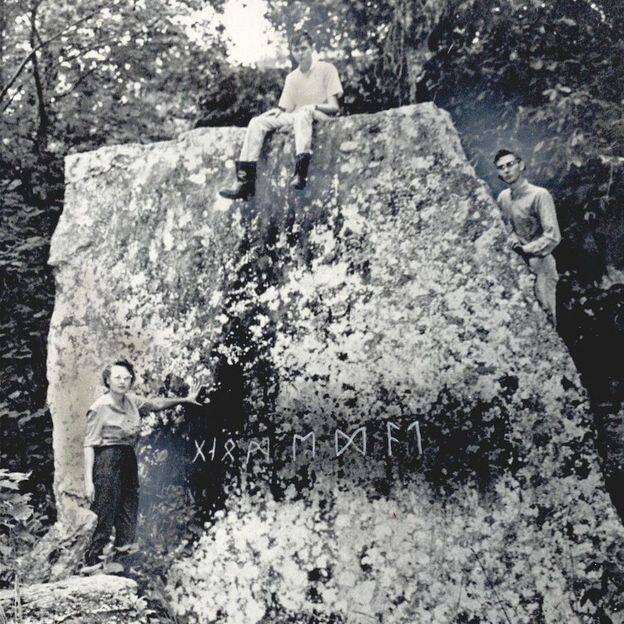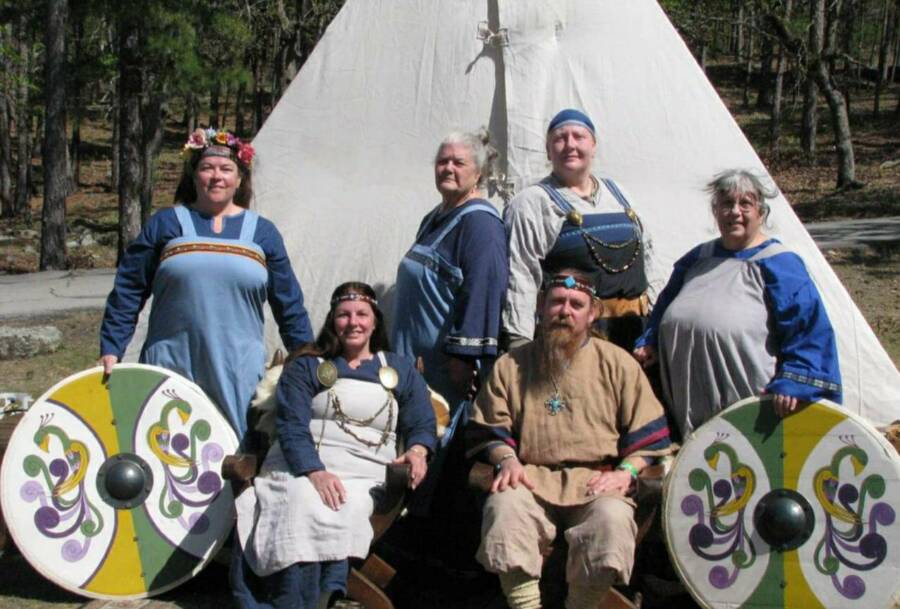
We are not finding comparables in England, iceland or Greenland or are we? You see my point. I do think that their penetration of our world was robust but never colonizing so much as passing through. The exception to that was certainly vinland in Vancouver Island by way of the northwest pasage, The black hills by way of Greenland and James Bay which gets us to oklahoma, and plausibly in New England as well.Of course, please do not forget england and russia. It is soon obvious were they actually colonized heavily.
If expeditions left behind inscriptions, then we really should know this. There were plenty of prospective locales were we knew thgey were heavy on the ground. what vis inportant is that we do not need fake inscriptions to support a slew of cultural tales. those boys wernt everywhere but had plenty to colonize close to home.
The Heavener Runestone And Its Mysterious Inscription That Some Say Proves Vikings Traveled To Oklahoma
By Amber Breese | Edited By John Kuroski
Published July 8, 2023
Updated July 10, 2023
https://allthatsinteresting.com/heavener-runestone-oklahoma?
The Oklahoma Runestone, located in Heavener Runestone Park, was first discovered in the 1830s, but some believe it had been left by Viking explorers hundreds of years before.
Oklahoma Tourism & Recreation DepartmentThe mysterious runic inscriptions on the Heavener Runestone, found in the Ouachita Mountains in east Oklahoma.
Ever since she first saw the Heavener Runestone as a young girl, Gloria Farley was obsessed with unlocking the secrets behind the symbols carved into this eastern Oklahoma curiosity.
This massive, eight-symbol stone carving, measuring roughly 10 feet by 12 feet, has puzzled scholars for decades. Why did these Scandinavian-looking runes appear in this landlocked region of America, and who is responsible for creating them?
For believers like Farley, the Oklahoma Runestone proves that Vikings sailed up the Mississippi River over 1,000 years ago. For others, the stone is an elaborate hoax with more modern origins.
This is the divisive story of the Oklahoma Runestone.
The Astonishing Discovery Of Oklahoma’s Heavener Runestone

Courtesy of the Oklahoma Historical SocietyGloria Farley and her sons with the Oklahoma Runestone in 1971.
The earliest mention of the Oklahoma Runestone came from the late 1830s when a Choctaw hunting party stumbled upon the runes. Since then, locals in the area mistakenly referred to the rock as “Indian Rock,” believing that Native Americans made the inscriptions.
In 1928, local girl Gloria Farley began her obsession with researching the inscriptions and discovering their true origin.
“[Farley] spent the majority of her adult life researching the stone,” Amanda Garcia, Heavener Runestone Park manager told BBC. “She traveled all around the U.S., went to Egypt and went to different places looking at different markings.”
During her quest, Farley reached out to Smithsonian regarding the Oklahoma Runestone, and they told her that whoever wrote the inscriptions did so in a Scandinavian language.
The runes read “GNOMEDAL,” a combination of “gnome” and “dal” meaning “sundial valley” or “monument valley.”
With more pieces to the puzzle, Farley wanted to know why and how the Scandinavian script came to be there.
Unlocking The Mystery Of Vikings In America

Wikimedia CommonsLeif Erikson Discovers America by Hans Dahl.
With new information from the Smithsonian, Farley began contemplating whether Scandinavian explorers could have carved the runes into the Oklahoma Runestone.
The idea that Viking settlers could have made it to America was not novel.
Many scholars believe that Leif Erikson, a Norse explorer, managed to travel to modern-day Canada nearly 500 years before Columbus. Two sagas from 1200 detail Erikson’s voyage to “Vinland,” or modern-day Newfoundland.
With this in mind, Farley didn’t think it was unreasonable that some Vikings may have traveled up the Mississippi.
“I began to believe that the symbols on the stone indicated that Norsemen had visited the area before the time of [Christopher] Columbus. I renamed the rock ‘The Heavener Runestone’ and began my search for similar inscriptions in the area,” Farley wrote in her book In Plain Sight: Old World Records in Ancient America.
“If the Vikings had sailed to Russia, Ireland, England, France and to the far end of the Mediterranean, why would it have been impossible for them to reach Oklahoma via the Mississippi River?” Farley questioned.
Farley believed that Vikings could have sailed along the Newfoundland seaboard, eventually reaching Florida and sailing into the Gulf of Mexico.
“The Poteau River is just a few miles from here,” Park Manager Garcia said. “Don’t think about how the waterways look now. Before all [the] man-made lakes and dams, these little creeks were big rivers and waterways back then.”
Over time, Farley became the leading voice of this theory, and her convictions only strengthened when locals found two more runestones a mile apart.
Archaeologists And Experts Weigh In On The Oklahoma Runestones
Despite Farley’s fervent beliefs that Vikings were responsible for the inscriptions, other scholars and experts aren’t so sure.
“The veracity of the Heavener stone as a Viking artifact is problematic. The linguistic evidence is ambiguous,” Lyle Tompsen, an archaeologist specializing in the Viking period, wrote in a paper about the stone.

Oklahoma Tourism & Recreation DepartmentHeavener Runestone Park in southeast Oklahoma.
Additionally, Tompsen noted that the inscriptions on the Oklahoma Runestone and the other two runic inscriptions nearby do not match Old Norse grammar and structure.
In 2015, Henrik Williams, professor in Nordic languages at the University of Uppsala in Sweden, also voiced his doubts about the inscriptions’ authenticity, telling the Southwest Times Record, “All words have endings, back 1,000 and 500 years ago,” in reference to the fact that the Oklahoma inscriptions do not have definitive endings.
“[The lack of ending] is one thing we find disturbing,” he said.
Additionally, the language on the stone seems to be something other than Old Norse in origin.
“The inscriptions are not a Viking script, but a combination of Elder Futhark and Younger Futhark, which predates when the Vikings would have been traveling,” Dennis Peterson, an archaeologist, and manager of the Spiro Mounds Archaeological Center, stated to BBC.
Another issue with the Oklahoma Runestone: There is no definitive layout.
“None of the American inscriptions ever found have any kind of layout or ornamentation. That’s another thing that doesn’t really fit the pattern,” Williams noted.
Finally, the presence of Vikings inscriptions in Oklahoma is hard to believe given the sheer lack of inscriptions in places historians are sure Vikings once lived.
“There are no Vikings or earlier inscriptions on Iceland or Greenland, so it’s a big jump from Sweden to Heavener.”
With expert opinion casting doubt on Farley’s theory, the question remains: Who inscribed the Oklahoma Runestone and why?
The Heavener Runestone’s Legacy As A Site Of Wonder And Curiosity
“Barring any new evidence, the stone is best considered a modern creation,” Tompsen concluded in his paper.
By modern, Tompsen believes that the stone is likely from the 19th century.
“Historical evidence from the 19th century covering both the Viking Revival, Scandinavian immigration, and the lack of archaeological evidence of Norse excursions to the Western U.S.,” Tompsen wrote, “strongly suggests the stone is a 19th-Century creation of a Scandinavian immigrant (likely a Swedish immigrant working at the local train depot).”
Peterson agrees with Tompsen, writing to the BBC, “It’s a higher probability that somebody who learned Elder Futhark in school came through and left the equivalent of graffiti.”
Other theories about the stone’s origin include mentions of the La Salle expedition of 1687 that claimed Louisiana for France or a Swedish captain who led German colonists to the area in the early 18th century.

FacebookParticipants in the Heavener Runestone Festival, which celebrates the area’s possible connection to Vikings.
The plethora of theories attracts thousands of visitors to the Oklahoma Runestone annually. From Viking enthusiasts to enjoyers of the outdoors, many visit the site and can’t help but contemplate their own theories about how the inscriptions got there.
“We had a gentleman from Austria, and his sole purpose to come to the U.S. was to see the runestone,” Garcia said to the BBC.
“When I first started here five years ago, we had around 400 people a month; now we have that many in a week. Depending on different times of the year, we could have 2,000 people or more on a regular weekend,” Garcia continued.
The Oklahoma Runestone’s possible Viking connection even inspired an annual festival that has been active for the last 10 years. Vendors, re-enactors, and visitors all make the pilgrimage to the site to take part in a celebration of Vikings in America — regardless of whether it is historically accurate.
After all, though the possibility that Vikings sailed to Oklahoma is slim, it would be more than enough reason to celebrate.
No comments:
Post a Comment